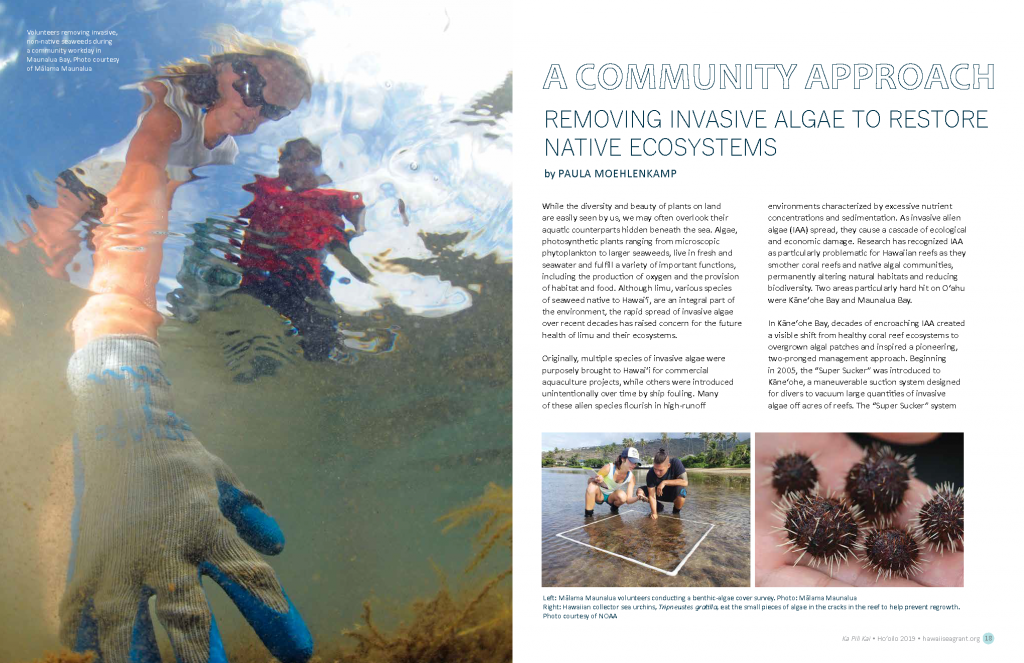While the diversity and beauty of plants on land are easily seen by us, we may often overlook their aquatic counterparts hidden beneath the sea. Algae, photosynthetic plants ranging from microscopic phytoplankton to larger seaweeds, live in fresh and seawater and fulfill a variety of important functions, including the production of oxygen and the provision of habitat and food. Although limu, various species of seaweed native to Hawai‘i, are an integral part of the environment, the rapid spread of invasive algae over recent decades has raised concern for the future health of limu and their ecosystems.
Originally, multiple species of invasive algae were purposely brought to Hawaiʻi for commercial aquaculture projects, while others were introduced unintentionally over time by ship fouling. Many of these alien species flourish in high-runoff environments characterized by excessive nutrient concentrations and sedimentation. As invasive alien algae (IAA) spread, they cause a cascade of ecological and economic damage. Research has recognized IAA as particularly problematic for Hawaiian reefs as they smother coral reefs and native algal communities, permanently altering natural habitats and reducing biodiversity. Two areas particularly hard hit on Oʻahu were Kāneʻohe Bay and Maunalua Bay.
In Kāneʻohe Bay, decades of encroaching IAA created a visible shift from healthy coral reef ecosystems to overgrown algal patches and inspired a pioneering, two-pronged management approach. Beginning in 2005, the “Super Sucker” was introduced to Kāneʻohe, a maneuverable suction system designed for divers to vacuum large quantities of invasive algae off acres of reefs. The “Super Sucker” system targeted Gracilaria salicornia and Kappaphycus/Eucheuma spp., troublesome species of smothering algae. The second phase of management began in 2011 with the introduction of tens of thousands of nickel-sized Hawaiian collector urchins, which naturally graze on algae, clearing reefs and promoting coral growth.
Researchers soon saw a drastic decline of non-native seaweeds, with some invasive populations disappearing entirely from Kāneʻohe by 2015. Adding further encouragement, studies have shown that the mechanical removal had minimal environmental impact and did not cause damage to important reef building species such as corals and crustose coralline algae.
Managers of Maunalua Bay have taken a different approach. Historically, the bay was a complex coral reef ecosystem, including sandy and grassy sectors, now surrounded by urbanized watersheds in southeast Oʻahu. Known to be one of the first settlements when Polynesians migrated to Hawaiʻi, Maunalua Bay is rich with Native Hawaiian history and culture. Its abundant marine life made it an ideal place for fishing, and it became home to multiple fishponds. Over time, human activities, such as excessive land-use, pollution, and overfishing, have combined with the spread of invasive algae to cause the degradation of coastal coral reefs, affecting marine life and impacting the ecological, economic, and cultural value of Maunalua Bay. For Mālama Maunalua, a local grassroots organization committed to preserving and protecting the area’s remaining natural and cultural resources, invasive algae removal is one of its key management practices.
In 2009, Mālama Maunalua partnered with The Nature Conservancy and Pono Pacific, a local business, to use government stimulus funds to address the invasive algae problem. The group targeted removal of three invasive algae: Gorilla Ogo (Gracilaria salicornia), Leather Mudweed (Avrainvillea lacerata), and Prickly Seaweed (Acanthophora spicifera). Their goal was to encourage community participation in removing the densest invasive algae growth to promote ecological restoration of coral reefs and seagrass beds. Ultimately, this stimulated not just the ecosystem but also local employment and community engagement, and these efforts are thriving even a decade later.
On organized community workdays, called huki, volunteers collectively remove invasive, non-native seaweeds from pre-selected plots in neighboring Paiko Bay, an area within Maunalua. “Every plot is scientifically assessed both before and after each removal event to determine impact. We maintain data on each assessment to help guide future removal efforts,” explains Doug Harper, executive director of Mālama Maunalua. Its management strategy also includes seeding native limu, enhancing native herbivory with sea urchins, and decreasing local nutrient and sediment runoff to create an ideal environment for native species to succeed.
“One of the biggest issues we confront is the inaccessibility of some algae populations. We are making significant strides in the Paiko area due to our fantastic community support, but some parts of the bay remain inaccessible. We suspect there are colonies of invasive algae in those locations we worry are able to prosper and seed other parts of the bay.”
Nevertheless, the results are rewarding. Due to its efforts, Mālama Maunalua has seen the extent and volume of invasive algae drop, the return of native algae increase, and consequently a shift back to benthic sand instead of choking mud. A secondary benefit is that the nutrient-dense algae removed are sustainably utilized at local farms and serve as excellent fertilizer and insect repellent on crops like taro and sweet potatoes.
For these important sites around Oʻahu, the battle against invasive algae will continue, whether by applying vacuums, recruiting urchins, or through old-fashioned manual weeding. But the efforts have proven invaluable: wherever native limu has been given a second chance to thrive, local ecosystems and communities have been equally enriched.
Browse Ka Pili Kai issues HERE


